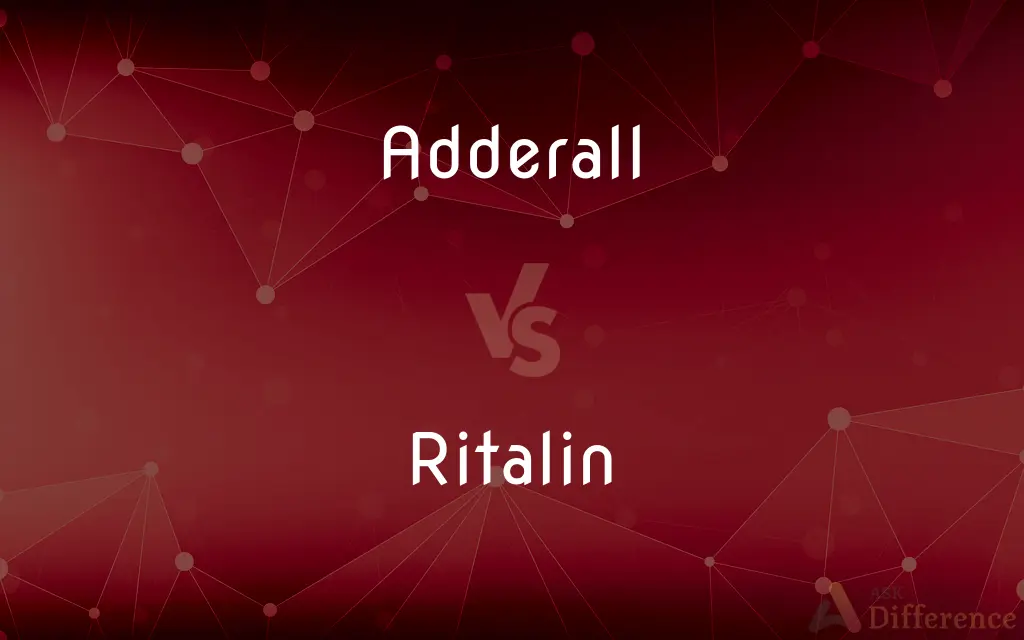Adderall vs. Ritalin — What's the Difference?
By Tayyaba Rehman — Updated on September 23, 2023
Adderall and Ritalin are prescription stimulants for ADHD, but Adderall contains amphetamine salts while Ritalin contains methylphenidate.

Difference Between Adderall and Ritalin
Table of Contents
ADVERTISEMENT
Key Differences
Adderall and Ritalin are both central nervous system stimulants commonly prescribed for attention deficit hyperactivity disorder (ADHD). Adderall, composed of a mixture of amphetamine salts, is known for its ability to increase attention span, concentration, and overall cognitive performance. Ritalin, on the other hand, contains the active ingredient methylphenidate, which similarly helps improve focus and reduce impulsivity.
Both Adderall and Ritalin have been used for several decades to treat ADHD in both children and adults. However, their mechanisms, while similar, operate somewhat differently within the brain. Adderall releases dopamine and norepinephrine, neurotransmitters responsible for attention and alertness. Ritalin primarily works by blocking the reuptake of dopamine and norepinephrine, making more of these neurotransmitters available in the brain.
While both medications can be effective for managing ADHD, they have distinct side effects and drug interactions. Adderall might lead to a rapid heart rate, insomnia, or increased blood pressure. Ritalin, though having similar side effects, may also cause stomach pain or nervousness in some individuals. It's essential for patients to discuss these potential side effects with their healthcare provider.
Furthermore, the duration of action varies between Adderall and Ritalin. Adderall generally has a longer-lasting effect, which might be beneficial for those requiring extended focus. Ritalin, while effective, often has a shorter duration, possibly requiring more frequent dosing. This difference could influence a doctor's decision on which medication is best suited for a particular patient.
Comparison Chart
Active Ingredient
Mixture of amphetamine salts
Methylphenidate
ADVERTISEMENT
Mechanism of Action
Releases dopamine and norepinephrine
Blocks reuptake of dopamine and norepinephrine
Common Side Effects
Rapid heart rate, insomnia, increased blood pressure
Stomach pain, nervousness, insomnia
Duration of Action
Longer-lasting
Shorter duration
Approved Age for Use
Children over 3, adolescents, and adults
Children over 6, adolescents, and adults
Compare with Definitions
Adderall
Can increase concentration and decrease impulsiveness.
After starting Adderall, Jake found it easier to complete tasks without getting distracted.
Ritalin
A prescription medication used for treating ADHD.
Ritalin has been a common treatment for ADHD since the 1960s.
Adderall
Contains a combination of amphetamine salts.
Adderall's effectiveness stems from its blend of amphetamine salts.
Ritalin
Enhances focus and reduces symptoms of impulsivity.
Taking Ritalin helped Emily stay on task during her studies.
Adderall
May cause side effects like insomnia or increased heart rate.
Sarah stopped taking Adderall due to her difficulty sleeping at night.
Ritalin
Side effects might include nervousness or stomach pain.
Max experienced stomach discomfort after starting Ritalin.
Adderall
Available in immediate-release and extended-release forms.
The doctor prescribed Adderall XR for all-day symptom relief.
Ritalin
Typically has a shorter duration of effect than some alternatives.
Because Ritalin wears off by the evening, Liam takes it twice daily.
Adderall
A stimulant medication primarily used to treat ADHD.
Many college students misuse Adderall to enhance focus during exams.
Ritalin
Contains the active ingredient methylphenidate.
The effects of Ritalin are due to its methylphenidate content.
Adderall
Adderall and Mydayis are trade names for a combination drug containing four salts of amphetamine. The mixture is composed of equal parts racemic amphetamine and dextroamphetamine, which produces a (3:1) ratio between dextroamphetamine and levoamphetamine, the two enantiomers of amphetamine.
Ritalin
(pharmaceutical drug) methylphenidate, used to treat attention deficit hyperactivity disorder
Ritalin
Central nervous system stimulant (trade name Ritalin) used in the treatment of narcolepsy in adults and attention deficit disorder in children
Common Curiosities
Are there age restrictions for these medications?
Adderall is approved for children over 3, while Ritalin is for children over 6.
What is the primary use of Adderall and Ritalin?
Both are used to treat ADHD.
How does Adderall differ from Ritalin chemically?
Adderall contains amphetamine salts, while Ritalin contains methylphenidate.
Which medication lasts longer?
Adderall generally has a longer-lasting effect than Ritalin.
Can both medications cause insomnia?
Yes, both Adderall and Ritalin can lead to sleep disturbances.
Share Your Discovery

Previous Comparison
Gabardine vs. Worsted
Next Comparison
Saute vs. SearAuthor Spotlight
Written by
Tayyaba RehmanTayyaba Rehman is a distinguished writer, currently serving as a primary contributor to askdifference.com. As a researcher in semantics and etymology, Tayyaba's passion for the complexity of languages and their distinctions has found a perfect home on the platform. Tayyaba delves into the intricacies of language, distinguishing between commonly confused words and phrases, thereby providing clarity for readers worldwide.















































